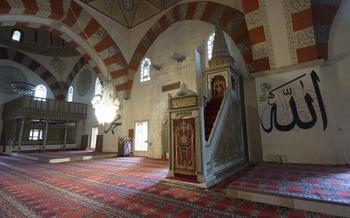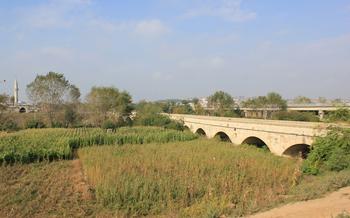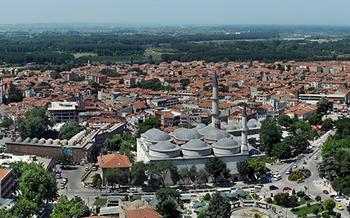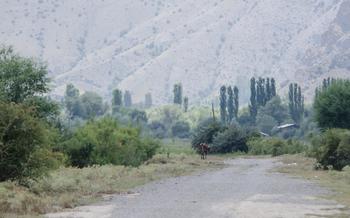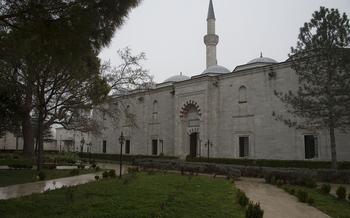
Üç Şerefeli Mosque
- Üç Şerefeli Mosque: A Majestic Symbol of Edirne
- History and Background
- Architectural Marvel
- Intricate Interior
- Landmark of Islamic Heritage
- Cultural Significance
- Visiting the Üç Şerefeli Mosque
- Exploring Edirne's Treasures
- Religious Significance
- Symbolism of the Three Balconies
- The Mosque's Legacy
- A Masterpiece of Calligraphy and Decor
- Experiencing the Mosque's Ambiance
- A Symbol of Unity and Diversity
- Insider Tip
Üç Şerefeli Mosque: A Majestic Symbol of Edirne
The Üç Şerefeli Mosque, meaning "three-balconied mosque", stands as a majestic symbol of Edirne, a city in northwestern Turkey. Built by Sultan Murad II between 1438 and 1447, this architectural masterpiece showcases the grandeur and artistry of Ottoman architecture. Its historical significance is intertwined with the rise of the Ottoman Empire and its status as the capital city before the conquest of Istanbul. As an Islamic landmark, the mosque holds immense religious and cultural value, serving as a place of worship, pilgrimage, and Islamic learning. The three balconies, a unique feature of the mosque, symbolize its architectural uniqueness and reinforce its religious and spiritual importance.
History and Background
The Üç Şerefeli Mosque, a testament to Ottoman architectural prowess, was commissioned by Sultan Murad II in 1438 and completed in 144Its construction marked a significant milestone in the development of Edirne, which served as the capital of the Ottoman Empire during the 15th century. The mosque's design was heavily influenced by Byzantine architecture, reflecting the empire's cultural diversity and its commitment to preserving historical heritage.
The mosque's most striking feature is its three balconies, a unique element in Islamic architecture. These balconies symbolize the three holy cities of Islam: Mecca, Medina, and Jerusalem. They also represent the mosque's status as a prominent center for Islamic learning and scholarship, attracting students and scholars from across the empire.
The Üç Şerefeli Mosque played a pivotal role in the development of Edirne as a major Islamic center. Its construction marked the city's transformation into a vibrant hub of religious and cultural activity. The mosque became a symbol of the city's growing importance and its status as a center of Islamic power.
Architectural Marvel
The Üç Şerefeli Mosque stands as a testament to Ottoman architectural prowess, showcasing unique design features that set it apart from other mosques. Its most striking characteristic is its three balconies, which are not only a symbol of its architectural uniqueness but also a representation of the three holy cities of Islam: Mecca, Medina, and Jerusalem. The balconies are intricately carved with delicate stonework, adding to the mosque's overall grandeur.
The mosque's exterior is adorned with intricate tilework and decorative motifs, showcasing a harmonious blend of Ottoman and Byzantine elements. The tiles, in shades of blue, green, and turquoise, create a vibrant visual tapestry that complements the mosque's majestic stone facade. The interplay of colors and patterns reflects the mosque's dual heritage, symbolizing the fusion of Islamic and Byzantine architectural traditions.
The mosque's interior is equally impressive, featuring elegant pillars that support the spacious prayer hall. The mihrab, or prayer niche, and the minbar, or pulpit, are exquisitely carved and decorated, adding to the mosque's overall elegance. The interior is bathed in a soft, ethereal light that filters through the stained-glass windows, creating a serene and inviting atmosphere conducive to prayer and reflection.
Intricate Interior
The interior of the Üç Şerefeli Mosque is a testament to the skill and artistry of Ottoman craftsmen. The prayer hall is spacious and airy, with elegant pillars supporting the high ceiling. The walls are adorned with stunning calligraphy and decorative motifs, creating a vibrant and visually appealing space.
The mihrab, or prayer niche, is a particularly impressive feature. It is intricately carved from marble and features elaborate tilework. The minbar, or pulpit, is also beautifully crafted from wood and features intricate carvings and inlay work.
The overall effect of the interior is one of serenity and spirituality. The combination of the elegant architecture, the beautiful calligraphy, and the soft light filtering through the windows creates a space that is conducive to contemplation and prayer.
Landmark of Islamic Heritage
The Üç Şerefeli Mosque stands as a shining example of Islamic architecture, showcasing the prowess and creativity of Ottoman builders. Its innovative design and intricate details have left an enduring legacy on Islamic mosque design, influencing subsequent mosques across the region. The mosque's grandeur and beauty have made it a symbol of Islamic architectural achievement, a testament to the cultural and religious significance it holds for Muslims worldwide.
The mosque's three balconies, a unique feature in Islamic architecture, further emphasize its importance. These balconies represent the three holiest cities in Islam: Mecca, Medina, and Jerusalem, highlighting the mosque's connection to the Islamic world's spiritual centers. The balconies also symbolize the mosque's architectural prowess, demonstrating the Ottoman architects' ability to blend traditional and innovative elements to create a truly awe-inspiring structure.
Cultural Significance
The Üç Şerefeli Mosque stands as a testament to the rich cultural heritage of Edirne and Turkey. It is a symbol of Turkish and Islamic identity, embodying the country's deep-rooted history and cultural traditions. As a part of Turkey's historical and cultural tapestry, the mosque represents the country's past as a major Islamic power, a time when it was a center of learning and culture. The mosque's presence in Edirne serves as a reminder of this rich past and contributes to the city's unique cultural identity. Moreover, the mosque's architectural beauty and historical significance make it a popular tourist attraction, drawing visitors from around the world who come to admire its grandeur and learn about its cultural significance.
Visiting the Üç Şerefeli Mosque
Location and accessibility:
The Üç Şerefeli Mosque is prominently situated in the heart of Edirne, Turkey. It stands as a majestic landmark, easily accessible to visitors. To reach the mosque, one can take a leisurely walk through the city's charming streets or utilize convenient public transportation.
Dress code and cultural etiquette:
As a place of worship, the Üç Şerefeli Mosque adheres to specific dress codes and cultural etiquette. Visitors are expected to dress modestly and respectfully, covering their shoulders and knees. Women are encouraged to wear headscarves as a sign of respect for Islamic customs.
Guided tours and self-exploration:
Guided tours are available for those seeking a comprehensive understanding of the mosque's history and significance. These tours provide insightful commentary, allowing visitors to delve deeper into the mosque's architectural features and cultural importance. Alternatively, visitors can embark on a self-guided exploration, taking their time to admire the mosque's intricate details and soak in its spiritual ambiance.
Respectful behavior and photography guidelines:
Visitors are kindly requested to maintain a respectful demeanor while exploring the mosque. This includes speaking softly, avoiding disruptive behavior, and refraining from touching or leaning against the mosque's sacred artifacts. Photography is permitted, but visitors are advised to be mindful of the ongoing religious activities and avoid capturing images of individuals without their consent.
Exploring Edirne's Treasures
Edirne, the charming city in northwestern Turkey, offers a plethora of historical sites and cultural attractions beyond the Üç Şerefeli Mosque. Embark on a journey to discover Edirne's hidden gems and immerse yourself in its rich heritage.
Visit the Selimiye Mosque, another architectural masterpiece designed by the renowned architect Mimar Sinan. Marvel at its soaring dome, graceful minarets, and intricate tilework that rival those of the Üç Şerefeli Mosque.
Explore the vibrant bazaars and markets of Edirne, where you can haggle for traditional Turkish handicrafts, souvenirs, and local delicacies. Indulge in the city's culinary delights, such as the famous Edirne köfte (meatballs) and the sweet treat of şekerpare (syrup-soaked pastries).
Discover the city's historical landmarks, including the Edirne Palace, the Rüstem Pasha Caravanserai, and the Great Synagogue. Each site narrates a chapter of Edirne's rich past, showcasing its diverse cultural heritage.
As you wander through Edirne, embrace the warmth and hospitality of its people. Engage in conversations with the locals, savor the flavors of Turkish cuisine, and immerse yourself in the city's vibrant atmosphere. Edirne promises an unforgettable journey that will leave you with lasting memories.
Religious Significance
As a place of worship, the Üç Şerefeli Mosque holds immense religious significance. Muslims from near and far flock to this sacred site to offer their prayers and seek spiritual guidance. The mosque serves as a center for Islamic learning and scholarship, where scholars and students gather to study the Quran and other Islamic texts. It is also a symbol of unity and devotion, bringing together people from all walks of life to worship and celebrate their shared faith. The mosque's majestic presence and intricate architecture create a serene and spiritual atmosphere, conducive to contemplation and inner peace.
Symbolism of the Three Balconies
The three balconies, or minarets, of the Üç Şerefeli Mosque hold significant symbolism. Primarily, they represent the three holy cities of Islam: Mecca, Medina, and Jerusalem. This connection reinforces the mosque's religious significance as a center of worship and pilgrimage.
Moreover, the three balconies symbolize the mosque's architectural uniqueness. They are a distinctive feature that sets the mosque apart from other Ottoman mosques. The minarets' height and design add to the mosque's grandeur and visual impact, making it a recognizable landmark in Edirne.
The three balconies also reinforce the mosque's religious and spiritual importance. They serve as a reminder of the mosque's dedication to Islam and its role as a place of prayer and contemplation. The minarets' graceful curves and intricate details reflect the beauty and elegance of Islamic architecture, further enhancing the mosque's spiritual aura.
Lastly, the three balconies showcase Ottoman artistic creativity. Their unique design and ornamentation demonstrate the skill and artistry of Ottoman architects and craftsmen. The balconies are not merely functional elements but also works of art, contributing to the mosque's overall aesthetic and architectural significance.
The Mosque's Legacy
The Üç Şerefeli Mosque stands as a testament to the enduring legacy of Ottoman architecture. Its innovative design and intricate details have left an indelible mark on the history of Islamic architecture. The mosque served as a model and inspiration for subsequent mosque designs throughout the Ottoman Empire and beyond, perpetuating its influence on Islamic architectural traditions.
Today, the Üç Şerefeli Mosque remains a symbol of Edirne's rich cultural and historical heritage. Its enduring presence serves as a reminder of the city's significance as a center of Islamic scholarship and architectural prowess. The mosque continues to draw visitors from around the world who come to marvel at its beauty and experience the spiritual essence that it embodies.
A Masterpiece of Calligraphy and Decor
The Üç Şerefeli Mosque is a testament to the exquisite craftsmanship and artistry of the Ottoman era. The interior of the mosque is adorned with intricate calligraphy, tilework, and decorative motifs that showcase the skill and creativity of Ottoman artisans. The calligraphy, in particular, is a masterpiece, with verses from the Quran and other religious texts inscribed in elegant and flowing Arabic script. The tilework, featuring vibrant colors and intricate patterns, adds to the mosque's visual appeal and creates a sense of awe and wonder. These decorative elements not only enhance the mosque's aesthetic beauty but also serve as a reminder of the importance of art and craftsmanship in Islamic culture.
Experiencing the Mosque's Ambiance
Stepping inside the Üç Şerefeli Mosque, visitors are enveloped in a palpable sense of tranquility and spirituality. The serene surroundings, devoid of any distractions, create an atmosphere conducive to contemplation and inner peace. The soft light filtering through the stained-glass windows casts a warm glow upon the intricate tilework, adding to the mosque's ethereal ambiance. The rhythmic chanting of prayers echoes through the vast prayer hall, further enhancing the sense of devotion and awe that permeates the air. Here, amidst the architectural splendor and religious significance, visitors can find a refuge from the bustling city outside, a place to connect with their spiritual selves and experience the profound peace and tranquility that the mosque exudes.
A Symbol of Unity and Diversity
The Üç Şerefeli Mosque stands as a testament to the diversity and unity that characterize Turkey's cultural heritage. The mosque's architecture seamlessly blends Ottoman and Byzantine elements, reflecting the region's rich history of cultural exchange and coexistence. This harmonious fusion of styles symbolizes the mosque's role as a bridge between different cultures, a symbol of religious tolerance and understanding.
Within the mosque's walls, people from all walks of life come together to pray, meditate, and seek spiritual guidance. The mosque serves as a reminder of Turkey's diverse religious traditions and the power of faith to unite people from different backgrounds. It is a place where differences are celebrated and commonalities are embraced, fostering a sense of community and belonging.
The Üç Şerefeli Mosque stands as a symbol of Turkey's commitment to preserving and celebrating its cultural heritage. It is a reminder of the country's rich history of cultural exchange and coexistence, and its dedication to promoting religious tolerance and understanding.
Insider Tip
For photography enthusiasts, capturing the grandeur of the Üç Şerefeli Mosque requires a wide-angle lens to encompass its sweeping scale and intricate details. Take a leisurely stroll around the mosque to appreciate its architectural nuances, ensuring you capture the harmony of the Ottoman and Byzantine styles. The mosque's spiritual ambiance is most palpable during the morning or evening prayers, offering a serene and contemplative atmosphere.

